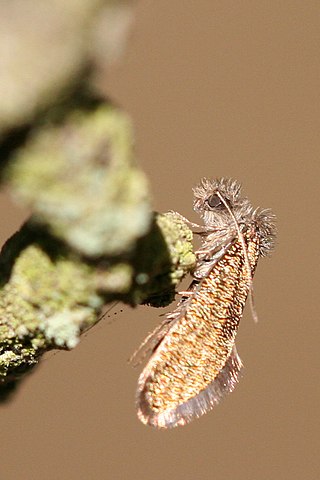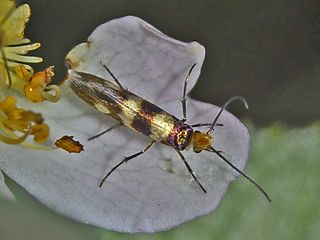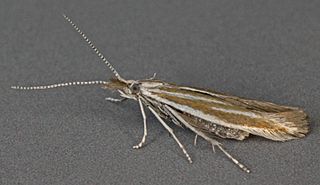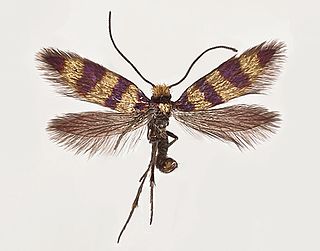
Micropterix is a genus of small primitive metallic moths, in the family Micropterigidae within the insect order Lepidoptera. The name was raised by the German entomologist, Jacob Hübner in 1825 and comes from the Greek for mikros, little and pterux, a wing. The moths are distributed across Europe, south to North Africa and east as far as Japan.

Dyseriocrania subpurpurella is a diurnal moth from the family Eriocraniidae, found in most of Europe. The moth was first named by the English entomologist, Adrian Hardy Haworth in 1828.

Eriocrania semipurpurella is a moth of the family Eriocraniidae, found from Europe to Japan and in North America. It was first described by James Francis Stephens in 1835. The species closely resembles Eriocrania sangii and the larvae of both species mine the leaves of birch.

Micropterix aureatella is a moth of the family Micropterigidae found in the Palearctic realm, except for North Africa.

Micropterix calthella, the marsh marigold moth, is a species of moth belonging to the family Micropterigidae. It is found in damp habitats throughout Europe and is also distributed eastwards to central Siberia. It was first described by Carl Linnaeus in 1761 as Phalaena calthella.
Micropterix isobasella is a species of moth belonging to the family Micropterigidae. It has a restricted alpine distribution in southern Switzerland and northern Italy.

Micropterix aglaella is a species of moth belonging to the family Micropterigidae.It is found in southern France, south-western Switzerland and northern Italy.

Micropterix aruncella is a species of moth belonging to the family Micropterigidae, which is distributed throughout Europe. The imago was first described by Giovanni Antonio Scopoli in 1763. This species is one of the best known members of the family, being found in a wide range of habitats from sea level to over 2,000 metres (6,600 ft); the only habitat not favoured by this species is dense woodland.

Eriocrania sangii, the large birch purple, is a moth of the family Eriocraniidae found in Europe and described by John Henry Wood in 1891. The moth can be found flying in sunshine around birch trees and the larvae feed on birch leaves.

Eriocrania unimaculella is a moth of the family Eriocraniidae found in Europe. It was first described by the Swedish naturalist Johan Wilhelm Zetterstedt in 1839. The larvae feed inside the leaves of birch, making a mine.

Eriocrania chrysolepidella is a moth of the family Eriocraniidae found in Europe. It was first described by the German entomologist, Philipp Christoph Zeller in 1851. The larvae mine the leaves of hazel and hornbeam.

Mompha raschkiella is a species of micromoth in the family Momphidae. The moth was first described by German entomologist Philipp Christoph Zeller in 1838.

Micropterix tunbergella is a moth of the family Micropterigidae found in most of Europe. The moths are very small and can be found feeding on the pollen of hawthorn, oak and sycamore. The larva and pupa are unknown. The moth was described Johan Christian Fabricius in 1787.

Micropterix allionella is a moth of the family Micropterigidae. It was described by Johan Christian Fabricius in 1794.
Micropterix fenestrellensis is a species of moth belonging to the family Micropterigidae. It was described by John Heath and T. Kaltenbach in 1984. It is known from Italy.
Micropterix myrtetella is a species of moth belonging to the family Micropterigidae. It was described by Philipp Christoph Zeller in 1850. It is found in Italy, Austria, the Czech Republic, Slovakia, Hungary, Croatia, Serbia and Montenegro, Albania, North Macedonia, Bulgaria, Greece, Romania and Ukraine.
Micropterix sicanella is a species of moth belonging to the family Micropterigidae that was described by Philipp Christoph Zeller in 1847. It is known from mainland Italy, Sicily, Sardinia and Corsica.

Coleophora pyrrhulipennella is a moth of the family Coleophoridae found in Europe. It was first described by Philipp Christoph Zeller in 1839.

Micropterix gaudiella is a species of moth belonging to the family Micropterigidae. It was described by Zeller and Huemer in 2015. It occurs in Italy.
Micropterix stuebneri is a species of moth belonging to the family Micropterigidae. It was described by Zeller, Werno and Kurz in 2013. It is only known from the Sierra Nevada in Spain.















